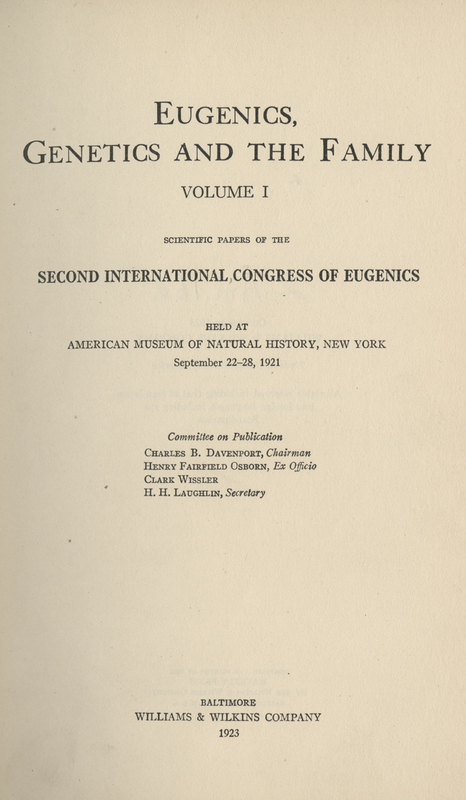Publications and Exhibits
There were three international meetings of eugenics researchers during the period of the movement’s greatest influence and activity. This volume reprints the scientific papers from the Second Congress, held at the American Museum of Natural History. Alexander Graham Bell was the honorary president of the Congress and Major Leonard Darwin, one of Charles Darwin’s sons and president of the Eugenics Education Society, delivered a keynote address.
Henry Fairfield Osborn, in his address of welcome, states, “In the United States we are slowly waking to the consciousness that education and environment do not fundamentally alter racial values. We are engaged in a serious struggle to maintain our historic republican institutions through barring the entrance of those who are unfit to share the duties and responsibilities of our well-founded government. The true spirit of American democracy that all men are born with equal rights and duties has been confused with the political sophistry that all men are born with equal character and ability to govern themselves and others, and with the educational sophistry that education and environment will offset the handicap of heredity.”
Harry Hamilton Laughlin was chairman of the Committee on Exhibits associated with the Second International Congress and organized this display at the American Museum of Natural History in the fall of 1921. A gift of $2,500 from Mrs. E. H. Harriman made the exhibit possible. There were 131 exhibitors from 22 states and 16 foreign countries, mounting displays on subjects of heredity, race, and applied eugenics.
Dr. Myrtelle May Canavan, pathologist with the Massachusetts Department of Mental Diseases and a member of the staff of the Boston Psychopathic Hospital, displayed enlarged photographs of fifty brains of criminals and feeble-minded individuals at the exhibition attached to the meeting of the Second International Congress in 1921. The exhibition catalog entry states that the criminal brains “were, for the most part, either very long or very round, with well developed pattern, probably indicating that the criminal is potentially well endowed but improperly uses his endowment. Most of the crimes were minor ones—breaking and entering, drunkenness, vagrancy, now and then a major crime of murder. It was striking, perhaps fortunate, that the majority of these men were unmarried.” This specimen, no. 576, shows the brain of a Canadian alcoholic vagrant whose mother died insane. Dr. Canavan and Louise Eisenhardt published this series of photographs as The brains of fifty insane criminals : shapes and patterns, in 1942.
For her contribution to the Second International Congress of Eugenics exhibit, Dr. Canavan was presented with a certificate of appreciation.



